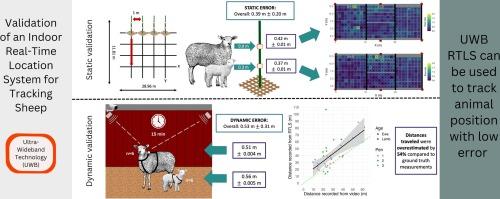验证用于追踪羊群的室内实时定位系统
IF 8.9
1区 农林科学
Q1 AGRICULTURE, MULTIDISCIPLINARY
引用次数: 0
摘要
远程传感器等精准牲畜技术越来越多地被用于监测牲畜的健康、行为和福利。我们的目的是评估市售超宽带实时定位系统(UWB RTLS)的性能,该系统用于跟踪肉用种母羊和羔羊在室内畜舍中的二维空间位置和移动距离。首先,我们将传感器安装在固定的柱子上,并在整个谷仓(29.0 × 11.8 米)内以 1 × 1 米的网格排列,共设 285 个位置,以此评估静态性能。在每个柱子位置,传感器被放置在母羊(0.9 米)和羔羊(0.3 米)的近似枯萎高度处。我们使用激光卷尺记录了每个柱子的精确二维位置,并将其作为地面实况与 RTLS 记录的 x 和 y 坐标进行比较。其次,我们进行了一次动态验证测试,以评估六只自由活动的母羊及其单羔佩戴传感器时的位置误差和距离误差百分比。在 15 分钟的时间里,每秒钟都会从视频帧中记录下每只羊的地面真实位置,并与 RTLS 数据进行比较。总体静态和动态误差分别为 0.39 ± 0.20 米(平均 ± SD)和 0.53 ± 0.31 米。羔羊高度传感器的静态误差低于母羊高度传感器的静态误差,但动态误差则相反。离主锚较远的围栏误差较大。地面实测距离和 RTLS 测距呈正相关,但 RTLS 测距平均高估了 54%。总之,UWB RTLS 可以获得精确的位置估计值,适用于一系列科学和实际应用,但距离估计值应根据高估情况进行调整。本文章由计算机程序翻译,如有差异,请以英文原文为准。

Validation of an indoor real-time location system for tracking sheep
Precision livestock technologies such as remote sensors are increasingly used to monitor the health, behavior, and welfare of livestock. We aimed to evaluate the performance of a commercially available ultra-wideband real-time location system (UWB RTLS) for tracking the 2D spatial locations and distances traveled by meat-breed ewes and lambs in an indoor barn. First, we assessed static performance by attaching the sensors to stationary posts and arranging them in a 1 × 1 m grid throughout the barn (29.0 × 11.8 m) for a total of 285 locations. At each post location, the sensors were placed at approximate ewe (0.9 m) and lamb (0.3 m) wither height. The precise 2D locations of each post were recorded using a laser tape measurer and used as the ground truth for comparison to the RTLS’ recorded x and y coordinates. Secondly, we conducted a dynamic validation test to evaluate the positional error and percent error of distances traveled while the sensors were worn by six free-roaming ewes and their singleton lambs. The ground truth locations of each sheep were recorded from video frames every second over 15 min and compared to the RTLS data. Overall static and dynamic error was 0.39 ± 0.20 m (mean ± SD) and 0.53 ± 0.31 m, respectively. Static error was lower in sensors positioned at lamb height than at ewe height, but the opposite pattern was true for dynamic error. Error was higher in pens further from the master anchor. Ground truth and RTLS distances traveled were positively correlated but the RTLS overestimated distances by 54 % on average. In conclusion, the UWB RTLS can acquire precise location estimates that are suitable for a range of scientific and practical applications, but distance estimates should be adjusted to account for overestimation.
求助全文
通过发布文献求助,成功后即可免费获取论文全文。
去求助
来源期刊

Computers and Electronics in Agriculture
工程技术-计算机:跨学科应用
CiteScore
15.30
自引率
14.50%
发文量
800
审稿时长
62 days
期刊介绍:
Computers and Electronics in Agriculture provides international coverage of advancements in computer hardware, software, electronic instrumentation, and control systems applied to agricultural challenges. Encompassing agronomy, horticulture, forestry, aquaculture, and animal farming, the journal publishes original papers, reviews, and applications notes. It explores the use of computers and electronics in plant or animal agricultural production, covering topics like agricultural soils, water, pests, controlled environments, and waste. The scope extends to on-farm post-harvest operations and relevant technologies, including artificial intelligence, sensors, machine vision, robotics, networking, and simulation modeling. Its companion journal, Smart Agricultural Technology, continues the focus on smart applications in production agriculture.
 求助内容:
求助内容: 应助结果提醒方式:
应助结果提醒方式:


